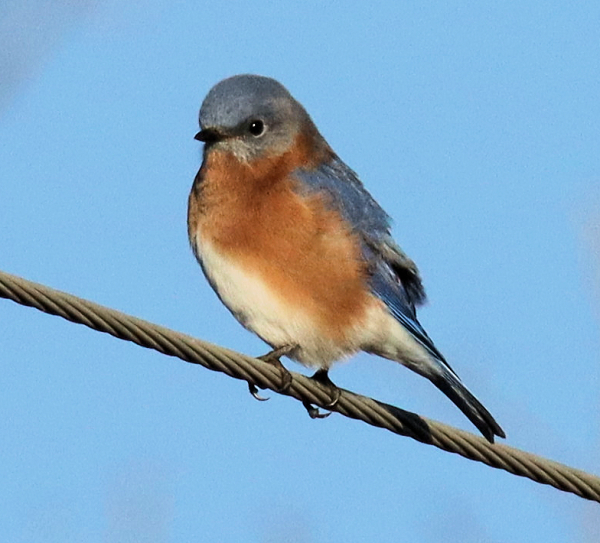
Eastern Bluebirds provided a surprise sighting and photos of a male (above) and female (below) in central Minnesota last week.
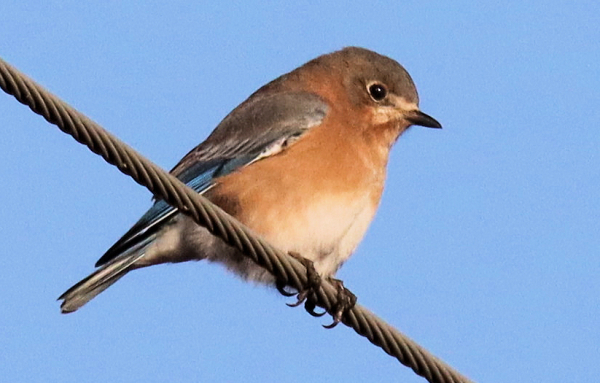
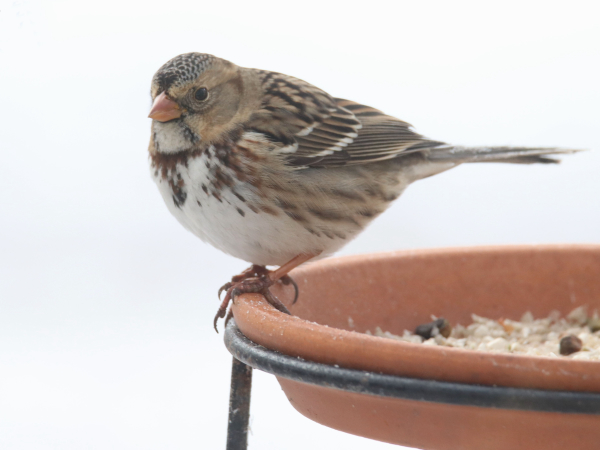
Usually a ground-oriented feeder, the first times a Harris’s Sparrow fed from one of Paul’s feeders was documented at his platform feeder Friday, and at this large tube feeder Tuesday.
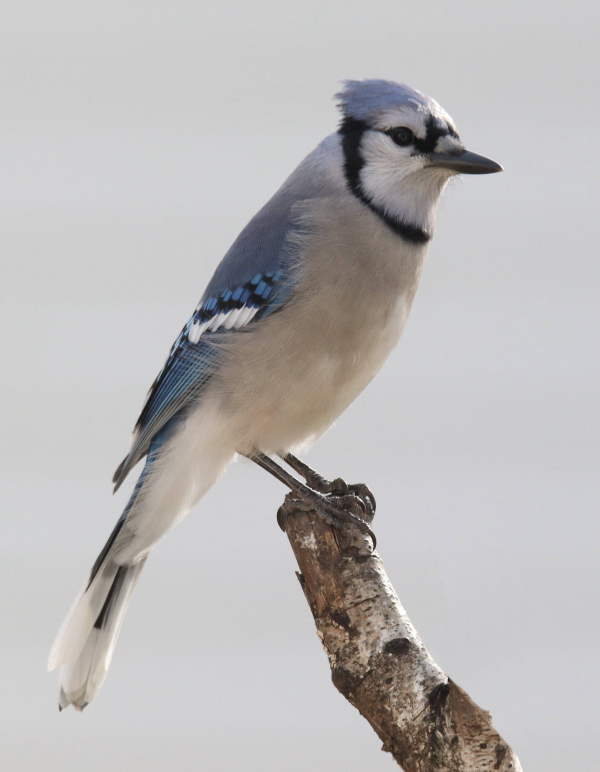
Blue Jays have been regular visitors since a platform feeder was added, along with more Pine Siskins and American Goldfinches.
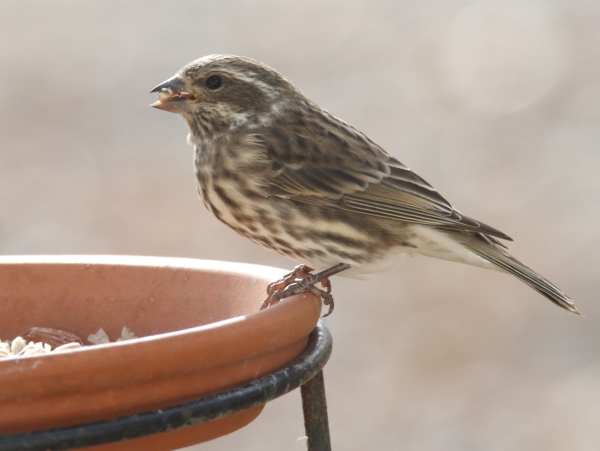
Purple Finches have been spotty visitors to the feeding station during the past week, including females (above) and males (below - it isn't the most colorful male).
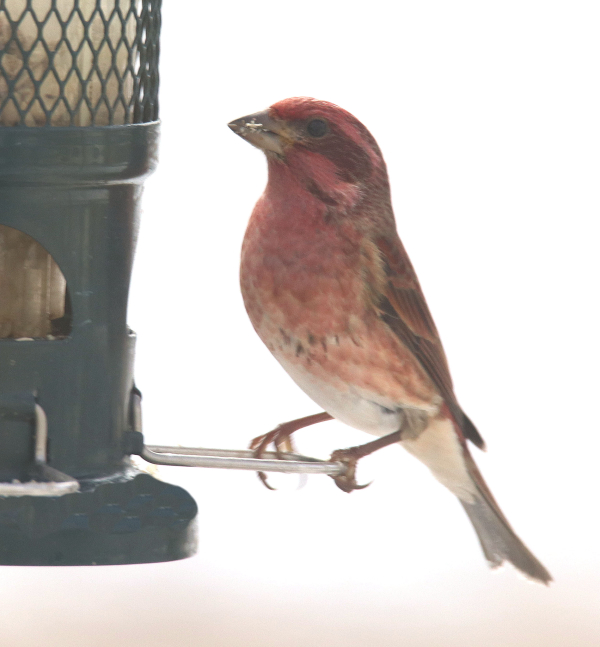
|
A Pileated Woodpecker and 3 Eastern Bluebirds were the biggest surprises during what became more of an exploratory birding drive in the lakes country southwest of Detroit Lakes, Minnesota. As always, Common Loons were a highlight, as was a Sharp-shinned Hawk, 2 Common Mergansers, 7 Bald Eagles, 8 Wood Ducks, 30 Trumpeter Swans, Mallards, and Canada Geese. With questionable sunshine forecast last Wednesday, I was lucky to follow the clearing sky east on what has become a weekly return to Minnesota lakes to check on the birds I might find.
While little changed at the Wood Duck marsh, with 8 Woodies and 30 Trumpeters on hand, a dramatic change took place at the sunflower field a half-mile west. Where I found and photographed a variety of birds feeding on black oil sunflower seeds in an unharvested sunflower field the week before, last Wednesday not a bird was present, if you don’t count the distant swarm of thousands of Red-winged Blackbirds that flew like a distant swirling cloud above the far side of the field. The field remained unharvested and looked the same, except for the lack of woodpeckers, chickadees, nuthatches, and goldfinches – I was a bit baffled.
When I returned down the road toward the Wood Duck marsh, I was disappointed to see a big road grader working its way along the south side of the marsh, displacing any hope of waterfowl returning to that important photo location. With the sunflower field and Wood Duck marsh showing little promise for photographs, I began a fall drive along the west sides of the lakes I’m most familiar with in the area – Sallie, Melissa, the Pelican Lakes, the Cormorant Lakes, and adjacent wetlands and rolling hills.
Single Common Loons were a big hit with me on the north ends of Lake Melissa and Big Cormorant Lake, now in full winter plumage. A Red-bellied Woodpecker was a nice surprise too, along with the Sharp-shinned Hawk and 3 Eastern Bluebirds – a female and 2 males. It was especially nice to see a male and female bluebird flying in tandem, showing their distinctive blue dorsal plumage as they banked to the side. Two female Common Mergansers were also a nice find. Although I was surprised by no sightings of Red-tailed Hawks, there were more Bald Eagles on hand, with just 1 second-year immature eagle and a scattering of 6 lone adult eagle sightings.
Back in my home range Thursday under cloudy, windy conditions I didn’t venture more than 2 miles in any direction from my office during a short afternoon drive. It was surprising to find there were no geese in the nearest lake where about 3,000 White-fronts and Snows have been basing their activities. Instead they moved to Dean’s Lake, about a mile to the east, where the segregated flocks of Snows numbered about 1,500 with White-fronts numbering about half that estimate. There were also 18 Tundra swans present along with 39 American Avocets. Rounding out Thursday’s avian finds were groups of 3 and 6 Bonaparte’s Gulls, not far from a dozen Ring-billed Gulls.
Bay Window Action
Earlier Thursday I started the week appreciating that the birds that burst onto the scene at my feeding station Tuesday were still on hand, most notably as many as 4 Blue Jays at a time, plus visits by male & female Purple Finches, American Goldfinches, Pine Siskins, and a male Hairy Woodpecker after not seeing a woodpecker for a week. The Blue Jays have been especially rewarding because the species has been absent during the previous 18 months, and because they add so much to the birds here, especially during fall and winter. White-breasted Nuthatches also kept the action lively at my feeders, along with House Finches.
Friday I was surprised by the first snowflakes falling, increasing in size and volume until the area outside my bay windows was covered in white with more snow falling. It seemed too warm for the snow to last, but it did, and with the first snowfall came an American Robin, the first I’ve seen in the area for more than a month, along with a Harris’s Sparrow and Dark-eyed Junco, and 2 female Purple Finches, plus jays, nuthatches, and the male Hairy Woodpecker. Then with snow on the ground, I took down my hummingbird feeder that November 1st.
Saturday began with a visit by a standout deep-red colored male Purple Finch, possibly the most colorful Purple Finch I’ve laid eyes on, and a first-ever visit by a Harris’s Sparrow to one of my feeders – my platform feeder. Usually these native sparrows are ground bound, but perhaps the snow cover required a behavioral switch, if only for a few hours. A welcome lunchtime visit by a female Downy Woodpecker was a first in many weeks; the male Hairy Woodpecker followed, and that’s when the snow began melting, and all the white stuff was gone by 3pm.
Swans, Raptors, & Whooping Cranes
Saturday afternoon, as the snow melted and fog lifted, I drove my raptor route northwest, which is also a swan route during fall. First I checked on local birds and found about 2,000 geese at Dean’s Lake just a mile northeast of my office – about 2/3 were Snows and 1/3 White-fronts – with 17 Tundra Swans too. At the next lake I counted 16 Bonaparte’s Gulls with about a dozen Ring-billed Gulls, and 4 more Bonaparte’s a mile farther. Swans were hit and miss along the way, with some regular lakes holding swans and others none; but I found groups of 34, 73, 65 at Cindy’s Lake, 2, 2, and 6 flying in a low V. It was surprising to see only one other flock of Snow and White-fronted Geese, numbering about 400, and there were flocks of Canada Geese numbering about 30, 60, 15, and 40.
As for raptors, the Red-tailed Hawks and Northern Harriers of October apparently vacated the region, but Rough-legged Hawks have definitely moved in from the Arctic, with 5 sighted during the first half of the drive. There was also a big second-year Bald Eagle perched on a branch of a lone cottonwood tree. Two flocks of upland birds were sighted, including 11 Sharp-tailed Grouse and 13 Ring-necked Pheasants (7 females and 6 males). Did I mention ducks? All the usual 10 species were present, with the most common being Lesser Scaup and Mallards.
It was an insightful look at birds in the Coteau, which I needed before the day of rain forecast for the full day of Sunday. However, on my way home at sunset, about 8 miles from my office a text dinged on my phone. I glanced at it to see a photo with the message 14 Whoopers, 2 young ones! I expected it was from my friends Chris and Barb, so pulled over (even though there wasn’t another car on the road for miles – ha) and sure enough, Barb sent me 3 photos she took with her cellphone, noting they were south of Bismarck along the Missouri River – about 100 miles from me.
When I reached home I called to get the scoop from my Bismarck High School classmates and appreciated their information and the exciting tip. Seeing Whooping Cranes during a migration stop between northern Canada and the Gulf Coast is one of the rarest sightings of all, especially given that there are only about 550 Whoopers in the wild migratory population! As noted, it was forecast to be raining all day Sunday, but Monday was expected to be bright and sunny for photography. The next morning, in the dark, I drove west – and the rest of the story follows in a Field Report on my interactions with the Whooping Cranes during Sunday and Monday field trips.
We all need a little excitement in our lives, some thrills, and birds help to add excitement to quench my mental thirst each week; but I must admit, Whooping Cranes have quite a dramatic effect on me. Add to that fact that this period has been filled with Tundra Swans, Snow Geese, White-fronted Geese, Wood Ducks, Trumpeter Swans, Common Loons, Northern Shrikes, Purple Finches, Harris’s Sparrows, Blue Jays, Bald Eagles, a Golden Eagle, and a Pileated Woodpecker to name a few of the birds that made my adrenaline spike last week. Can’t wait to see what appears this week! Enjoy all the birding thrills you can, along with the other wonders of life wherever you go and whoever you share time with day by day.
Article and Photos by Paul Konrad
Share your bird sightings and photographs at editorstbw2@gmail.com